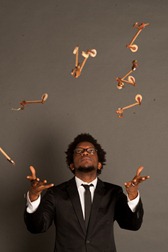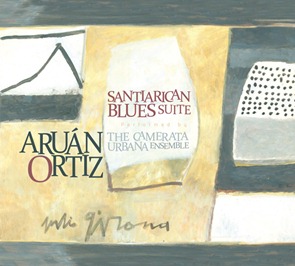Orbiting. Aruan Ortiz Quartet featuring David Gilmore, Eric McPherson and Rashaan Carter
&
Cuba may be more famous for defecting baseball players, who come to the U.S. to cash in on the big stage, but there are many more talents, and probably more important exchanges of culture going on than baseball. Aruán Ortiz is at the forefront of that exchange and one of many wunderkind in the music world hailing from Cuba. A classically trained violist and pianist, this Santiago de Cuba native’s sound is as marked by the influence of the contemporary classical composers such as Schoenberg, Ravel, and Copland as by traditional Afro Cuban sounds and jazz greats Bud Powell, Art Tatum, and Thelonious Monk.
Aruán’s jazz career took off in Europe after being the recipient of just about every meaningful award and he soon became the first call pianist in Barcelona and Paris. Since arriving in the US, he has played steadily with Wallace Roney, Antoine Roney, Terri Lyne Carrington, Greg Osby, and Cindy Blackman. He has also played or recorded with Esperanza Spalding, Gary Thomas, Wayne Krantz, Rasheed Ali, Stefon Harris, Horacio “El Negro” Hernández, Giovanni Hidalgo, George Garzone, Jane Bunnett, and Jerry Bergonzi among other great jazz artists.
What he brings to the table here, on these two albums, as in most of his work, isn’t just classical training, and ability to incorporate classical themes into his modern jazz composition. It also isn’t just the traditional Afro-Cuban sounds that have crept in and out of jazz for decades now. Its an ear for what has come to be called “world music”. Aruán’s ability to subtly incorporate world music elements into avant‐garde jazz makes his sense of creativity unique and recognizable in different styles. Additionally, his classical training makes him not only a virtuosic performer, but it allows him, or maybe a better word is compels him, to consider a wide variety of themes no matter what he is playing, composing or producing.
Orbiting brings out the avant-garde jazz side of Ortiz with compositions from the great Brazilian composer Hermeto Pascoal as well as jazz greats and his own compositions. The Pascoal composition is delivered with intensity and elan and, as was more or less the way the musicians were assembled for this album, it is an ensemble in motion. Each solo creates and states a different melodic/harmonic idea. The title piece, “Orbiting”, is inspired by the Bill Evans piece, “Orbit” which itself divided the rhythm from the melody and is here presented in ‘two sections’ seemingly unrelated – the drum/bass vibe lays a foundation and the syncopated melody seems to ‘orbit’ above it. This is not piano jazz.
The album continues in this vein with Ortiz’ own compositions (“The Heir” is for his son, Damian and is about life evolves on an unknown path), as well as tributes to greats of avant-garde, Charlie “Bird” Parker and Ornette Coleman. There is also explorations in cyclic phrasing, that musically explore the “math of music”, and are composed with a combinations of Fibonacci numbers amongst other things. The album doesn’t follow the usual avant-garde solo/accompaniment arrangements but is structured more as a unit; each piece plays parts that are standing its own ground throughout.
Featuring some of the greatest jazz musicians working today; David Gilmore on guitar, Rashaan Carter on bass and drummer, Eric McPherson. The album will be available on May 29 and you can preorder it now by following the links above.
Santiarican Blues Suite, as promised, is a different side of Aruan Ortiz and takes us, more or less, back to his roots. I say more or less because Cuban music, like Cuban culture as a whole is a melting pot of traditions and locations covering a good portion of the geographic map as well as the musical map. European, African and the music of the Caribbean all factor in. Here, Ortiz offers up a score for ballet that encompasses the cultural development of the furthest east province of Cuba; Oriente. Historically, this former province was a major hub of the slave trade. The lions share of the slaves imported into the province to work the sugarcane plantations came from Haiti and Ortiz himself is of Haitian-Cuban descent and hails from Santiago de Cuba.
This piece was originally written for the ballet Pagan Or Not to be performed by the Jose Mateo Ballet Theater in celebration of the company’s 25th anniversary. The suite is performed by piano, flutes, violins, viola, bass and percussion or in other words, more a classical, small acoustic ensemble than a jazz group. The piece is in the African Minuet form and explores the diverse influences in that small former province of Cuba – Franco-Caribbean, Spanish-Caribbean and Afro-Caribbean. like I said, it is a melting pot.
There are five separate movements here, ranging from “Diaspora”, a tribute to the Haitians taken from their adopted homeland of Haiti to again become slaves in Cuba. Master Cuban percussionist Mauricio Herrera’s drums stand out in the hesitation rhythms mirroring the uncertainty and dread of the immigrants. It wrings the emotion from the movement and infuses drama, very effectively. The next movement is “Pal Monte” with a beautiful vocal chant that turns into a song, native to Oriente. Traditional Haitian percussion is employed throughout. “San Pascual Bailon” is the middle movement and is a dance full of piano, flute and drums. It’s inspired by the Catholic procession in honor of the Saint of the title. The rhythm is peculiar to Haiti called tango haitiano, identified by the syncopation on the fourth beat.The fourth movement is “Sagrado” and is introduced by a sweet string piece that mimics the classical Cuban song “Perla Marina”. The melancholy builds between the harmonies of the strings and grand percussions parts. It’s probably the most “classical” part of the Suite and the f;lute parts seem to dance around the drums and above the strings. It’s a very appealing piece that begs you to stop and listen and I can only imagine how it would be with dancers performing at the same time. After all, this is ballet. The last movement, “Jubilee/Comparsa” opens with a flute fanfare that gives way to the strings, once again, laying a beautifully quiet string section. The flute repeats the melody of the song throughout as the strings expand and lift until the piece builds up to a European meets African elements in a Creole celebration. It ends up defining the musical stew that is Cuban modern music.
 Santiarican Blues Suite
Santiarican Blues Suite was released on April 10 and together with Orbiting
display two diverse sides of one of the greatest pianists working today in both avant-garde jazz as well as classical music. Aruán considers himself “a curious person who loves music”,and incorporates classical music, Middle Eastern, African, and Afro Cuban rhythmic elements into his compositions. He crosses borders and breaks down barriers, perhaps, more than any other musician working today. A virtuoso performer, and important composer, an award winning producer for other artists and, maybe most importantly as an educator. Check out his website for performances and other news. There’s no telling what other projects he may be juggling at any given moment.
Copyright © 2012 Robert Carraher All Rights Reserved





No comments:
Post a Comment